Collecting coins is fun, and a lot of people are doing it. If you are new to the coin collection hobby or want to add new coins to your collection, you need to consider getting the 1997 dime. It will not only complete your collection, but it can potentially increase the value of your sets.
Read on to learn the significant details about the 1997 Roosevelt Dime.
What Is the 1997 Roosevelt Dime Made Of?
One of the most interesting subjects about US coins is their composition. Thus, you might be curious about the composition of the 1997 Roosevelt Dime.
The 1997 dime is made of 75% copper and 25% nickel. It is part of the Roosevelt Dime series that was first struck in 1946 and is still being produced until this day. The dime was made of silver and copper when it was first struck. The same composition was used until the transition in 1965 when the dime turned into copper and nickel.
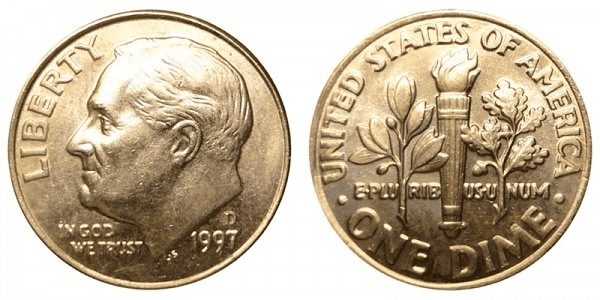
Now, let’s talk about the design of the coin. Looking at the obverse of the coin, you’ll find the image of Franklin Roosevelt facing to the left side of the coin. There are inscriptions, which include LIBERTY, IN GOD WE TRUST, JS, D, and 1997.
On the reverse, you’ll find three main images: the olive branch, the oak branch, and Liberty Torch. Inscriptions include UNITED STATES OF AMERICA, E PLURIBUS UNUM, and ONE DIME.
The US dime took on different designs before it became the Roosevelt Dime as you know it today. Here are the previous designs of the 10-cent US coin:
- Draped Bust
- Capped Bust
- Seated Liberty
- Barber
- Winged Liberty Head (aka Mercury)
1997 Roosevelt Dime Varieties
The 1997 Roosevelt dime comes in three varieties. These are the 1997 P, 1997 D, and 1997 Proof.
Here’s a table to show you the different varieties of the 1997 Roosevelt Dime as well as their mintage:
| Variety | Mint Location | Mintage |
| 1997 D Roosevelt Dime | Denver | 979,810,000 |
| 1997 P Roosevelt Dime | Philadelphia | 991,640,000 |
| 1997 S Proof Roosevelt Dime | San Francisco | 2,055,000 |
| Total | 1,973,505,000 |
After three consecutive years that the mintage of the US dime exceeded 2 billion, in 1997, it went down below the 2 billion mark. Nevertheless, the following year, the US Mint would again issue more than 2 billion dimes.
Here’s a quick look at the 1997 dime varieties as well as their mintage figure:
1997 D Roosevelt Dime
Year of minting: 1997
Mint Mark: D
Place of minting: Denver
Quantity produced: 979,810,000
Face Value: $0.10 (ten cents)
Price: $0.15 to $0.35 (circulated condition)
Mass: 2.27 grams
Edge: Reeded
Designer: John R. Sinnock
Composition: 75% copper, 25% nickel
Diameter: 17.90 millimeters
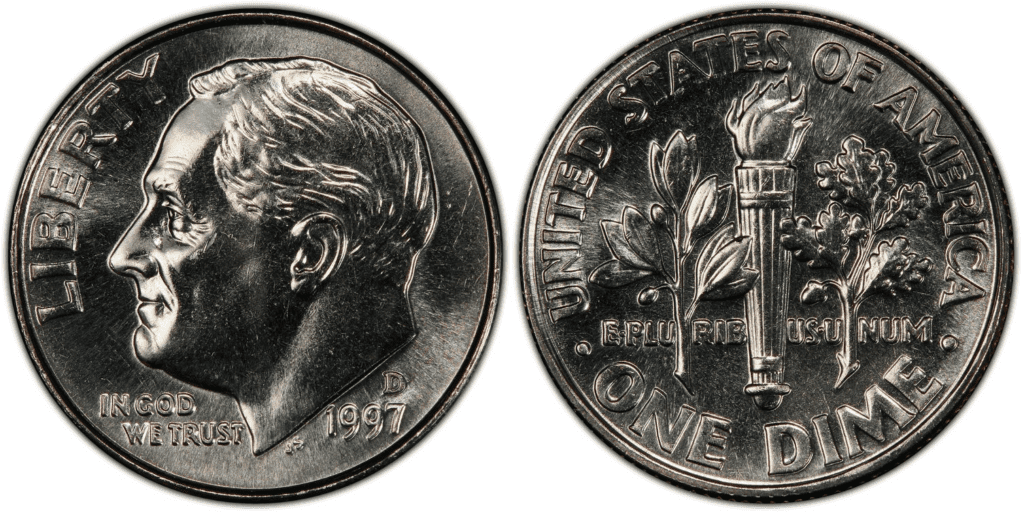
The Denver Mint produced almost one billion dimes in 1997, significantly lower than in 1996.
1997 P Roosevelt Dime
Year of minting: 1997
Mint Mark: P
Place of minting: Philadelphia
Quantity produced: 991,640,000
Face Value: $0.10 (ten cents)
Price: $0.15 to $0.35 (circulated condition)
Mass: 2.27 grams
Edge: Reeded
Designer: John R. Sinnock
Composition: 75% copper, 25% nickel
Diameter: 17.90 millimeters
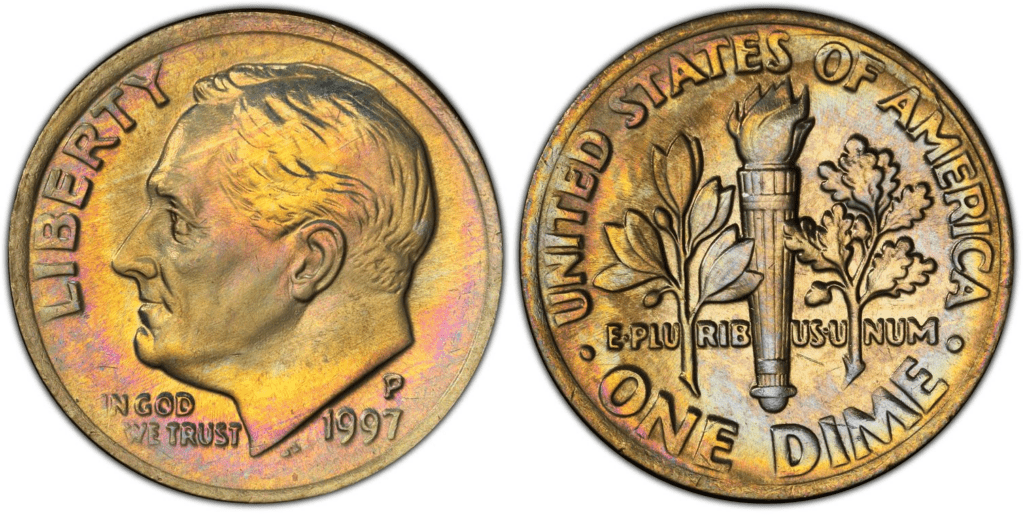
The Philadelphia Mint produced the most number of US dimes in 1997. They issued 991,640,000 dimes. This is the highest mintage figure for dimes in that year.
1997 Proof Roosevelt Dime
Year of minting: 1997
Mint Mark: S
Place of minting: San Francisco
Quantity produced: 2,055,000
Face Value: $0.10 (ten cents)
Price: $11 or more (uncirculated condition)
Mass: 2.27 grams
Edge: Reeded
Designer: John R. Sinnock
Composition: 75% copper, 25% nickel
Diameter: 17.90 millimeters

The San Francisco Mint produced more than 2 million proof dimes, which was quite impressive. This shows you that the demand for proof dimes in 1997 was high.
List Of 1997 Roosevelt Dime Errors
There were almost two billion dimes produced in 1997. So, you can expect that some coins received errors due to mechanical or human failure.
While error coins may sound negative, many collectors are interested in them. Here are some examples of 1997 Roosevelt dime errors:
Off-center strike error
The die and planchet should be properly aligned with each other. If not, then there would be an off-center strike error. When this happens, you’ll see that a portion of the die was struck outside of the planchet, leaving some parts of the coin missing.
Here’s an example of an Off-center strike error in a 1997 dime:
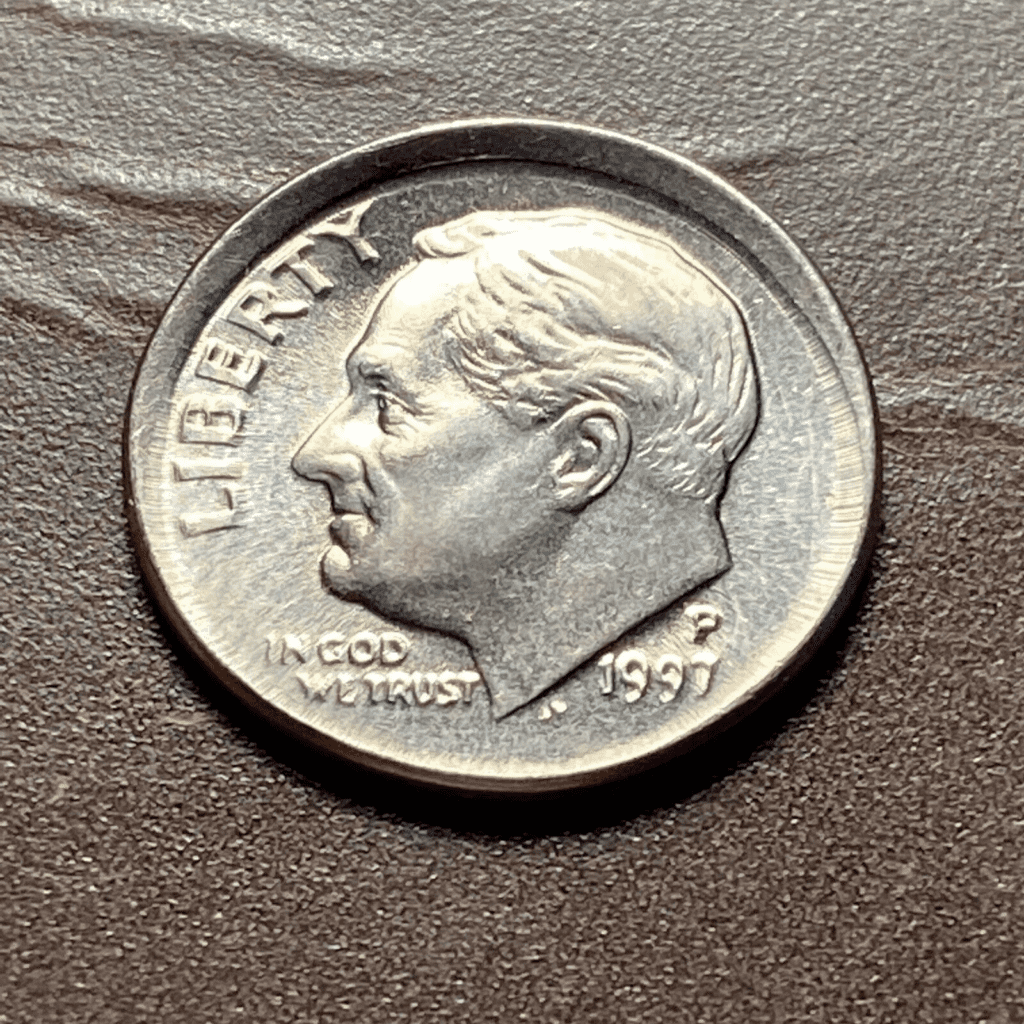
Broadstruck dime error
The die hits the planchet with a full force that could flatten the blank coin. To prevent this, a die collar would hold the coin in its place and prevent it from spreading out when the die hits the planchet.
However, sometimes, the die collar becomes loose, leading to the broadstrike error. Here’s what a broadstrike error would look like on a 1997 dime:

Clipped planchet error
The coins need to be cut properly to become a perfect circle as its shape. In one metal sheet, multiple coins are being cut. The problem happens when there’s a misfeed in the machine. The next cut of the coin hits the previous cut of the coin. This leads to a portion of the cut metal sheet being included in the next cut.
Here’s what the clipped planchet error looks like in a 1997 dime:
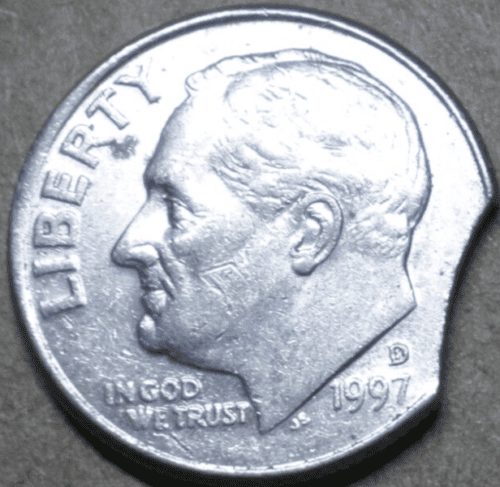
How Much Is 1997 Roosevelt Dime Worth Today?
Knowing the value of a 1997 Roosevelt dime should guide buying and selling transactions.
As its denomination suggests, the 1997 dime has a face value of 10 cents. Its melt value isn’t too high since the 1997 Roosevelt dime wasn’t made with precious metals. The melt value is $0.0237. If you’re looking for a circulated dime, you might pay around 50 cents for it.
As you can see, the face value and melt value of a 1997 Roosevelt dime aren’t much. However, you shouldn’t rely on those figures because 1997 Roosevelt dimes have a higher numismatic value. Some of them can be sold for a few hundred to thousands of dollars.
To give you an idea, here’s a table to show you the auction records for each 1997 dime variety:
| Coin | Condition | Grade | Sold date | Sold by | Value |
| 1997 D Roosevelt Dime | Superb Gem Uncirculated | MS 68 (Full Band) | October 21, 2020 | Heritage Auctions | $2,160 |
| 1997 P Roosevelt Dime | Superb Gem Uncirculated | MS 60 – (Full Band) | July 7, 2011 | Heritage Auctions | $1,265 |
| 1997 Proof Roosevelt Dime | Perfect Uncirculated | PR 70 – Deep Cameo | July 20, 2004 | Heritage Auctions | $374 |
How Does The Grading System Work?
The 1997 dime is graded based on color, luster, preservation level, and strike quality. Grading coins alone might not be a good idea, especially if you’re unfamiliar with the process. You can contact NGC, ICG, ANACS, and PCGS. These are the most recognized coin grading service providers.
Professional numismatists joined in the 1970s and established CoinGrading standards, known as the Sheldon Scale. These numismatists now assign grades at key places on the seventy-point scale, using the most regularly utilized numeric points in conjunction with the original adjective grade. The following are the most common coin grades:
- (P-1) Poor – Indistinguishable and probably damaged; if used, must have a date and mintmark; otherwise, rather battered.
- (FR-2) Fair – Nearly smooth, but without the damage that a coin graded Poor often possesses. The coin must have enough detail to be identified.
- (G-4) Fair – Inscriptions have merged into the rims in some areas, and important elements have been mostly erased.
- (VG-8) Very Good- A little weathered, but all primary design elements are visible, albeit faintly. There is little, if any, central detail left.
- (F-12) Good – The item is very worn, yet the wear is even, and the overall design details stand out clearly. Rims are almost completely isolated from the field.
- (VF-20) Very Fine – Moderately weathered, with some finer features still visible. The motto or all letters of LIBERTY are readable. Both sides of the coin have entire rims separated from the field.
- (EF-40) Extremely Fine – Gently used; all gadgets are visible, and the most important ones are bold. The finer details are bold and clear; however, light wear may be seen.
- (AU-50) Uncirculated – Slight evidence of wear on the coin’s design’s high points; it may have contact marks; eye appeal should be adequate.
- (AU-58) Uncirculated Choice – Slight traces of wear, no severe contact marks, almost full mint shine, and great eye appeal.
- (MS-60) Mint State Basal – Strictly uncirculated; no indication of wear on the coin’s highest points, but an unsightly coin with reduced luster, visible contact marks, hairlines, and other flaws.
- (MS-63) Mint State Acceptable – Uncirculated, but with contact scratches and nicks, little reduced shine, but otherwise appealing appearance. The strike is weak to average.
- (MS-65) Mint State Choice – Uncirculated with great mint shine, little contact blemishes, and exceptional eye appeal. The strike is unusually severe.
- (MS-68) Mint State Premium Quality – Uncirculated with superb luster, no obvious contact marks to the naked eye, and exceptional eye appeal. The strike is quick and appealing.
- (MS-69) Almost Perfect Mint State – Uncirculated with perfect brilliance, a sharp and appealing strike, and extremely good eye appeal. A near-perfect coin with minor imperfections in the planchet, strike, and contact markings (seen only under 8x magnification).
- (MS-70) Mint State Perfect – Under 8x magnification, no tiny imperfections are discernible; the strike is crisp, and the coin is perfectly centered on a beautiful planchet. Rarely seen on a coin, this coin is bright and whole, with original luster and exceptional eye appeal.
The dime has a special grading designation as well. An appraiser would determine whether your 1997 dime is Full Band or not. A Full Band dime has a detailed horizontal band on the Liberty Torch’s upper portion. Generally speaking, a Full Band dime is more expensive.
Where To Buy Or Sell 1997 Roosevelt Dime?
Buying and selling a 1997 Roosevelt Dime can easily and quickly be done online. For example, eBay is the most popular online platform to buy or sell US coins. There are thousands of US coins available on this platform. You can visit their website and look for 1997 Roosevelt dimes. What’s great about eBay is that you can also sell your Roosevelt dime on their platform.
Other popular websites include Amazon, Etsy, Coin Appraiser, and USA Coin Book. Just be careful when it comes to buying or selling on the Internet. Many scammers are out there and only transact with reputable and trusted vendors.
Of course, if the Internet isn’t your thing, you can look for coin shops around your place.
FAQs
How much does a 1997 dime weigh?
The 1997 dime weighs 2.27 grams.
How much is a 1997 dime worth today?
The 1997 dime has a face value of 10 cents. So, it is more likely that you will only be able to trade it at face value. Nevertheless, 1997 dimes are astronomically more valuable than their face value. As long as the 1997 dime is in good condition and is rare, it can be sold for hundreds or thousands of dollars. For example, an MS-68 1997 D Roosevelt dime was sold for $2,160 on October 21, 2020.
